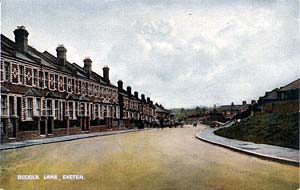
Buddle Lane
Page updated 2nd July 2010
Buddle Lane in St Thomas may have been named after the Budgell family who were landowners in St Thomas. William Budgell was admitted as a freeman to the city in 1564, along with a tailor named Thomas Budgell. Eustace Budgell also became a freeman in 1680 - he drowned himself in 1685 after a bequest of £2,000 in a will was set aside. He was facing ruin, as he had lost £20,000 in the South Sea Bubble
However, there is an alternate story behind the name - some say it was named after the springs of water that burst from holes in the road. My attention was recently drawn by a friend to the word 'buddle', used in processing manganese ore, which was once mined in Newton St Cyres. The 'buddle' was a sloping wooden trough that the crushed ore was washed on - could this be the origin of Buddle Lane?
The lane has also been known as Pound Lane after the cattle pound that was once present at one end of the lane; an advert, in 1876, for a cattle sale refers to a Farm Yard for the venue, probably the cattle pound. The area still had a number of substantial trees, for in 1892, an auction had two lots, of three elms, each lot for sale. The trees had already been felled, and were waiting collection by the side of the road.
There was a football ground off the lane in the 1890s where St Thomas held some of their home games. However, at that time, football could refer to rugby, for St Thomas beat St James 5 tries and several miners to 1 try and several miners in January 1889.
By 1900, the fingers of St Thomas were encroaching upon Buddle Lane, as Exeter's Street Committee recommended that a tender, from Mr J Pomeroy, for £424 14s to widen the footpaths of Buddle Lane and Dunsford Road be accepted.
The area became a place of
expansion for Exeter when the City Council built 64 council houses in
what was then a rural lane, in 1923.
The lane runs between Cowick Street and Okehampton Street, and
contains
the Green Gables Inn,
built by the City Brewery in 1935, an
a rather strange design which is a cross Dutch, Art-Deco. The inn was
built on the land of the Broadmeadow estate.
 Buddle Lane in the 1930s.
Buddle Lane in the 1930s.
 Buddle Lane from the
Cowick Lane end.
Buddle Lane from the
Cowick Lane end.
│ Top of Page │